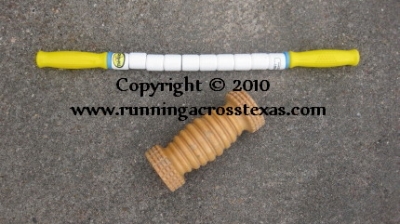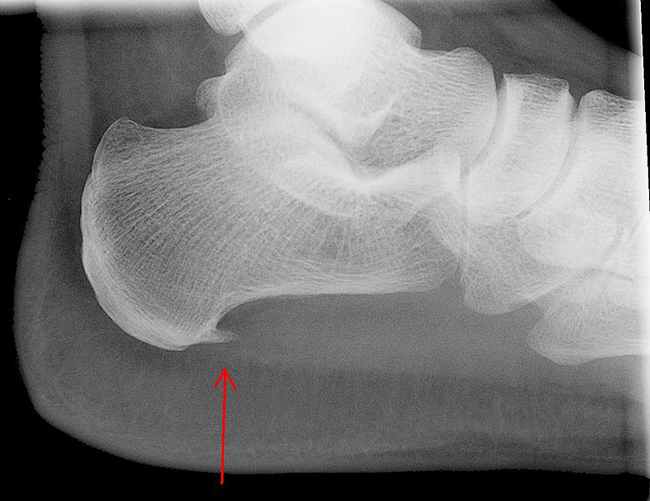Running and Friendly Links
Curing Plantar Fasciitis
A Common Running Injury may be Cured Without Corticosteroid Injections


Any runner, aerobics enthusiast, or participant in almost any sport other than yoga or synchronized swimming, will likely experience plantar fasciitis at some point. It’s been known to put both pro athletes and weekend warriors on the bench.
You might have heard the terms “flip-flop disease” or “dog’s heel”. It doesn’t matter what it’s called, you just want it to go away.
It will manifest as a heated type of pain on the foot’s bottom, usually located where your heel meets up with your arch. The plantar fascia itself is a section of connective tissue that stretches across the bottom of your foot, beginning at your heel and ending at the base of your toes.
Why is the Plantar Fascia Important?
What’s its purpose? Primarily to absorb shock on impact. Without it your bones and muscles wouldn’t stand much of a chance. The harder the running surface, the more impact it has to take.
The plantar fasciitis condition happens when small tears in the tissue show up. Usually this will occur with a sudden abrupt change in intensity or direction; sometimes overuse will do it.
Minimalist runners (barefoot or Vibram Five Fingers wearers) are especially at risk. The chance of injury is greatest early in the day before it has had a chance to be loosened up.
Delayed Treatment may Result in a Heel Spur


Left unattended, this condition may result in a heel spur (see the red area in the image above). This is a calcification of the heel bone. You may hear it referred to as a calcaneal spur; same thing.
Even sedentary people can develop this condition; in particular people who are obese, flat-footed, and women who constantly wear high-heeled shoes. As you can imagine, female runners that wear stiletto heels to work every day are at high risk!
Unless you go to a doctor that is well-versed in sports medicine, your plantar fasciitis treatment will be aspirin, corticosteroid injections, or something along that line. The issue with this approach is that remedies like these address your pain and not your basic problem.
He’ll probably advise you to quit running. The problem with this approach is that no runner wants to completely lose their mileage base so we need to look for another solution.
A Sports-Oriented Doctor has Better Advice
A sports type of doctor will be more likely to prescribe a night splint or a plantar fasciitis sleeve sock
. This approach really will help and is a good beginning to reaching a permanent cure. But to understand why more needs to be done, let’s look at the mechanics.
It is key to get your head around the fact that all connective tissues contract while at rest in order to repair themselves as we sleep; it’s part of the healing process.
What do folks do when the alarm clock begins its morning torment? Other than whacking the snooze button? They hop out of bed and load up their body weight on their feet as they shuffle off to the bathroom to obey the call of nature.
The Logical Cure
The result is that all the tissue repair to your plantar that occurred while you slept will be ripped again due to the combination of body weight and shrunk tissue.
This is precisely the reason why people afflicted with this condition will affirm that the torment is worse in the morning and diminishes as the day wears on. This daily routine takes on the face of the great movie Groundhog Day.
The solution? It should be intuitive, but if not, read on. The minute you wake up, deep massage the bottom of your ailing foot (or both of them if you’ve got the double-whammy).
Do this for five minutes, regardless of how loudly the bathroom is calling out. This will stretch out and loosen the tissue so that your body’s nightly repair will pay off.
In the best of all possible worlds your partner will perform the massage manually but most of us live in the real world where that just ain’t happening. So do it yourself or use a massage tool like “The Stick” or the “Runner’s Foot Roller” (both are pictured at the top of this article).
How to Prevent this Sports Injury
Finally, some runners are naturally inclined to get this and other injuries over and over due to individual biomechanics. Like the ability to run fast or long, this is a genetic matter and we can’t pick our parents, as they say.
One approach for long-term prevention is to invest in a pair of high-quality orthotics for correction (custom-made by a podiatrist, not off-the-shelf).
This can run into some money, but when the alternative is not running at all or big interruptions in training, well, sometimes we just have to bite the bullet.
More Sports Medicine Articles
- Diagnose and Treat Iliotibial Band Syndrome
- Stress Fracture or Shin Splints?
- How to Stop or Prevent a Side Stitch
- Specific Stretches Offer Relief for Runner’s Knee
- Evaluate and Treat Runners Knee
Visit Kelly's profile on Pinterest.
Website © 2010 KSmith Media, LLC; all rights reserved. Webmaster’s Google profile










